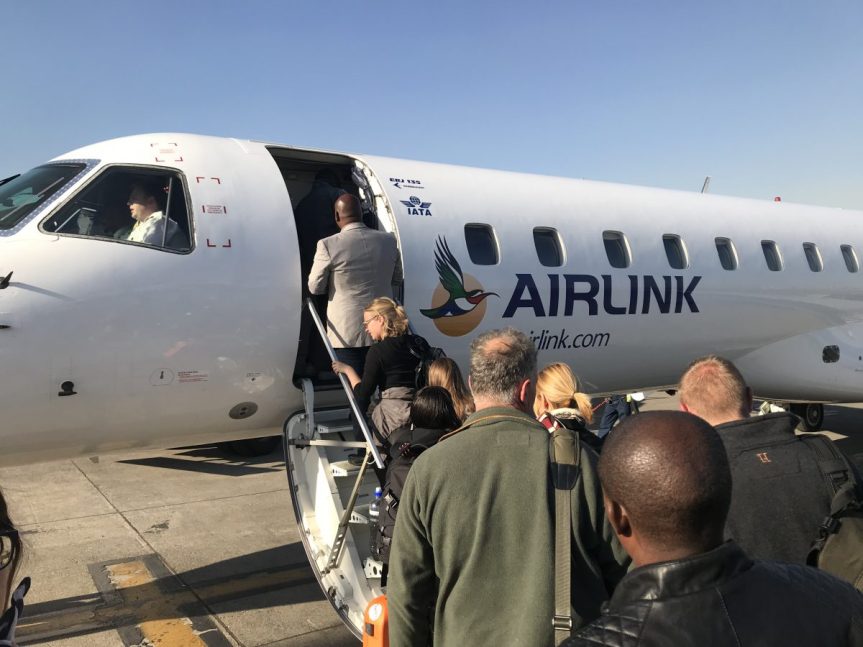Magical performance by William Kentridge and his team
This morning we set out for our last meeting in Johannesburg before we fly to Harare (Zimbabwe). We are heading for The Center for the Less Good Idea. As is often the case in Joburg, the street decor is constantly changing. One moment we drive through a rough-looking neighborhood. Then the van takes a turn and you are suddenly in a different world. A world of refurbished old factory halls and stylishly decorated cafes where people sit online behind their laptop. In short, comfortable locations but you can find them anywhere in the world.

The Center for the Less Good Idea is located in Maboneng Precinct, in the eastern part of the city; a neighborhood where gentrification has created not only places for artists but also hipster spots for coffee and food.

Bronwyn Lace is visibly busy but receives us friendly and efficient. Great is the surprise when the founding father of this place appears on the scene: William Kentridge. Both tell about the identity of the venue. The Center is in fact the ideal playground for artists and curators. Or as the website says: ‘an interdisciplinary incubator space for art’.

The beautiful name of the institution is a reference to the idea behind the original plan. Lace: “The less good idea is not a bad idea, but the idea behind the initial plan, the idea peripheral to it”. Artists must submit plans and account in the regular system for financing their work. There is little time in that system for the experiment and certainly too little room to deviate from the submitted plan if the process requires it. While very interesting things can happen there. Once again Lace: “This is a safe place for artists to fail; failure is a thing which is very important “. And Kentridge adds: “… giving the impulse the benefit of the doubt and what happens; that is in the core of this center “.
The center has a number of studios where artists from different disciplines work together for a period, learn from each other and make discoveries. Their is no open call; an artist must be invited. The period of research is finished with a final presentation. “To put some pressure on them” says Kentridge. The interdisciplinary nature of the institution is evident. Only this morning we meet visual coasters, a puppeteer, dancers (urban and classical educated), musicians (jazz and classical educated) and spoken word performer.
We are welcome in the studio of Gerard Marx. Under his hands a car has been reconstructed into a sculpture. Using electronics, ‘the car’ has been transformed into an instrument with, for example, the doors as sound boxes for strings. Marx is curious about the performative quality of musicians; to the relationship between looking and hearing. Today is the first time that the sound that is ‘captured’ in the instrument is discovered during an improvisation; with our group as an audience. After a few ‘knor, beeps, scratch’ sounds, some time later, the electronic potpouri creates a certain rhythm and a harmonious sound. A blessing for the ears.

But also exciting to experience how that moment arose from the improvisation of the musicians. Then we are treated to a short but powerful performance by an actor who, through an intervention by the director, sees his physical space limited to a round moving disc with a diameter of 1.5 m. And last but not least we see the pianist with the monkey, actually the collaboration between a classically trained pianist and a puppeteer.
The biggest surprise is yet to come: a gig has been arranged for us in the large hall of the complex. Kentridge was inspired by the Ursonate by the Dadaist Kurt Schwitters. We hang on his lips while he recites this aburdist text from 1932 with a beautiful diction and at the same time look at the parallel video projection. The ensemble is addressed in that part of the Ursonate where improvisation is prescribed. An explosion of sound, image and movement follows. The whole is certainly not inferior to the original performance, it is at the same time disruptive and moving.
Another moving conclusion is the knowledge that Kentridge is the financier of this beautiful place. In a country with few public funds for the arts and private financiers that seem to be more likely to go for ‘ power’ institutions that generate international visibility, Kentridge supports the experiment and the artists. The Center for the Less Good Idea is therefore unique and exemplary. How beautiful would it be if there were such playgrounds in other places in the world?
Annet Zondervan
On the way to Harare
After this amazing visit to the Center for the Less Good Idea the bus takes to the airport and we are on our way to Harare (Zimbabwe).







